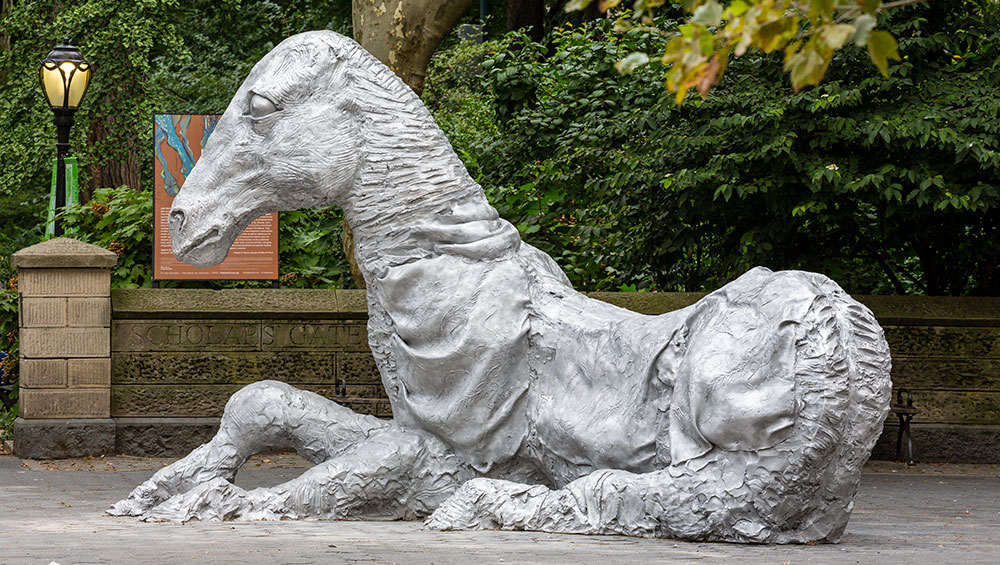
Jean-Marie Appriou, The Horses, 2019. Cast aluminum, courtesy of the artist and CLEARING, New York/Brussels; Galerie Eva Presenhuber, Zürich/New York. Presented by Public Art Fund, Doris C. Freedman Plaza, Central Park, Sep 11, 2019 - Aug 30, 2020. Photo: Nicholas Knight, Courtesy of Public Art Fund, NY.
by LILLY WEI
As Covid-19 upends all aspects of life as we know it, here and everywhere, New York-based artists and supporting institutions have scrambled to devise alternative ways to present art in a city where it is considered a staple of life. As pandemic time continues to creep in its petty pace, countless cultural events have pivoted online. The offerings have been surprisingly compelling, and, at the very least, they have been informative, connective and far better than none at all. New platforms for the dissemination of art, discourse, and, inevitably, commerce are eagerly being sought and launched. Silver linings as they may be, and most certainly part of our future when all this has become merely a bad memory, virtual still does not have the oomph of the real thing. With that in mind, the great outdoors beckoned, giving plein air new meaning, new zing.
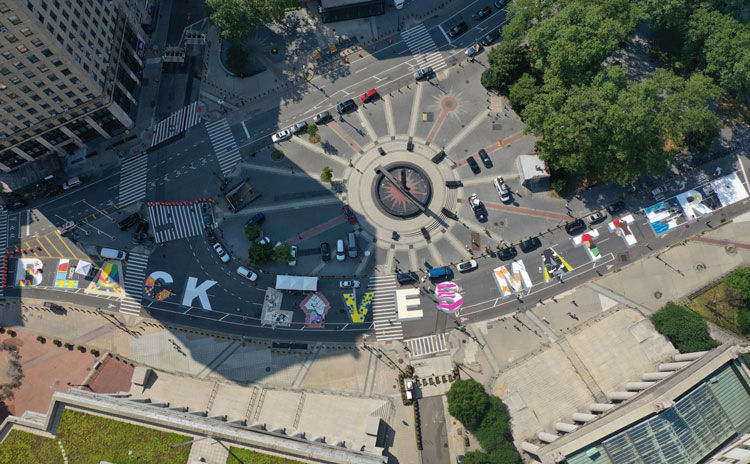
Black Lives Matter Street Mural, Centre Street, NYC. Organized by Percent for Art Program, NYC Department of Cultural Affairs. Photo: Courtesy Nightnurse.
Some of these outdoor exhibitions were normal programming scheduled in public art venues that are synonymous with New York’s cultural identity. Some were to be found in suddenly repurposed outdoor spaces. If, for instance, you were reluctant to descend into enclosed subway spaces, and missed their abundance of underground art, hundreds of bus shelters and thousands of electronic kiosks were mobilised as part of the Art on the Grid project organised by the Public Art Fund, located throughout all the boroughs, the art of 50 chosen artists on 24-hour display from 29 June to 20 September.
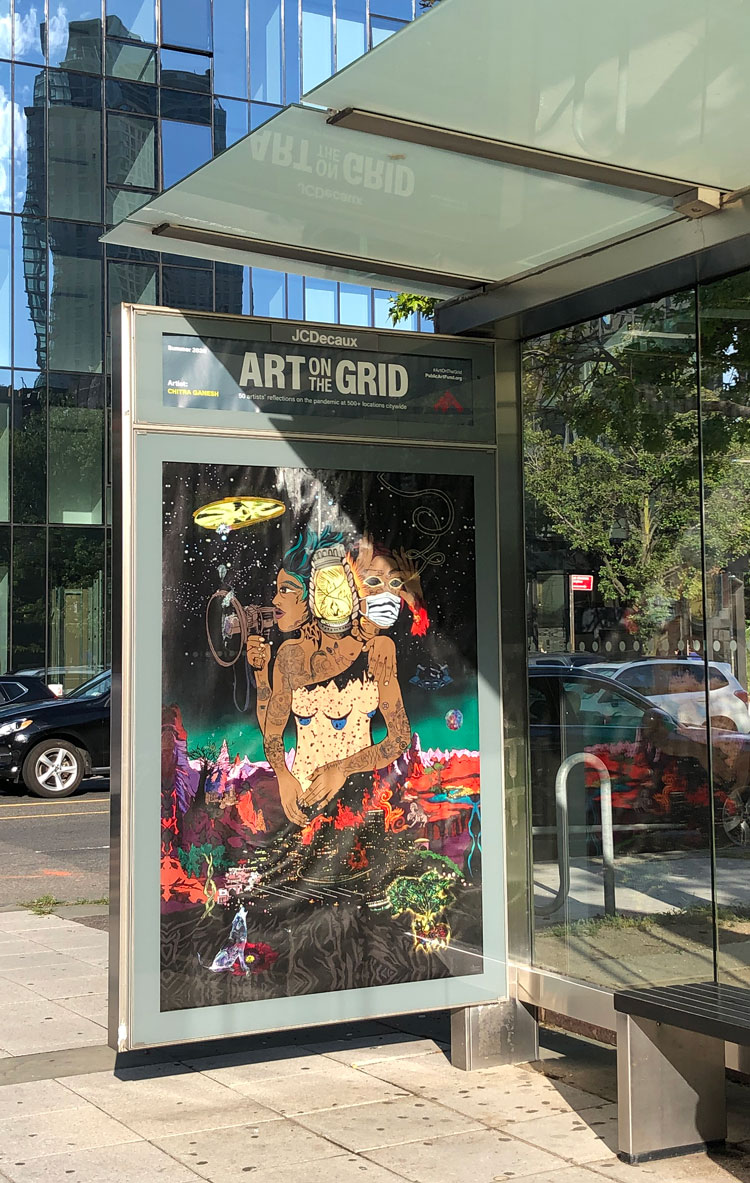
Chitra Ganesh, Urgency, 2020. Jackson Avenue and Thomson Avenue, Long Island City, NY. Photo: Lilly Wei.
Others were spontaneous, heartfelt responses to demands for human rights and social justice, to nationwide protests against police brutality. There were at least eight multiple blocks-long Black Lives Matter street murals to be found in all five boroughs during June and July and as retailers, restaurants and residents boarded up their buildings with sheets of plywood during the massive protests downtown and elsewhere, artists got busy, with some of the most frenetic, eye-popping results in SoHo. And, with typical New York zeal, it might be noted that a non-profit group is gathering up the painted plywood boards as they come down, conserving or recycling them for future projects.

SoHo Plywood Wall Murals. Photo: Hannah Alderfer, from her upcoming book, Watch Them.
A number of recent exhibitions have been drawing (relative) crowds (compared to only pigeons and other assorted creatures a couple of months ago) in August. One was the Rockefeller Center Flag Project, which showcased flags conceived by 13 high-profile artists – including Jeff Koons, KAWS, Sarah Sze and Faith Ringgold – accompanied by 180 public submissions, edging the perimeter of the center’s famous ice-skating rink with heartening messages and a defiant, upbeat flutter of colour.

Rockefeller Center Flag Project. Courtesy Rockefeller Center.
Another celebratory installation consisted of strips of a photographic image of sunflowers affixed to the steps of the sweeping 100-foot (35.5 metre) wide stone staircase of Louis Kahn’s Franklin D Roosevelt Four Freedoms State Park on Roosevelt Island. It created the illusion of a glorious field of the blazingly yellow flowers, the symbol of the American women’s suffrage movement.
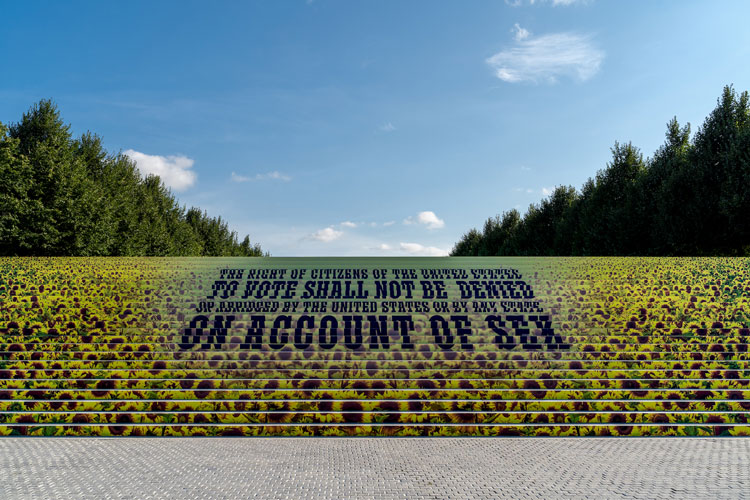
Field of Sunflower, Franklin Delano Roosevelt Four Freedoms State Park, Roosevelt Island. Photo courtesy Four Freedoms Park Conservancy.
In partnership with the park, the League of Women Voters and the New York Historical Society, it commemorated the 100th anniversary of the ratification of the 19th amendment, the field emblazoned with text that confirmed women’s inalienable right to vote (although black women were not able to cast a vote until the passage of the Voting Rights Act of 1965) and further stirs debate about the forthcoming US elections in November, likely to be one of the most contentious and consequential in the country’s history.
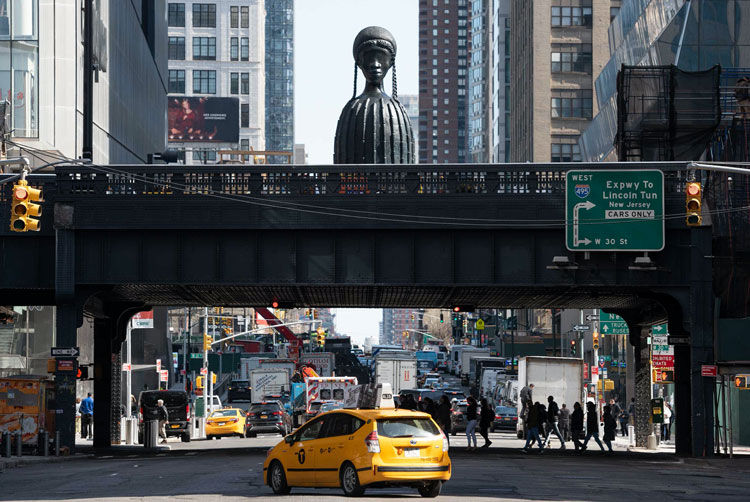
Simon Leigh, Brick House, 2019. High Line Plinth Commission. Photo: Timothy Schenck, courtesy High Line.
In Manhattan’s Hudson Yard vicinity, Simone Leigh’s Brick House has held court on the High Line for about 18 months. This is a commanding 16-foot bronze bust of a black woman, whose powerful torso is an amalgam of house and skirt. Both emblems of shelter, the architectural references in styles from West Africa and the American South, its content and intent challenges that of equestrian and other heroic (white) male monuments as they are being toppled from their pedestals across the nation. It was the inaugural commission for the High Line plinth at the Spur, the newest extension of the High Line that opened in June 2019. Leigh’s sculpture will (voluntarily) abdicate its memorable reign on the plinth in September. And indicative of the times, for two upcoming plinth commissions, the curators are soliciting outside comments as part of the selection process, an aspect of “public” in public art that is often ignored.
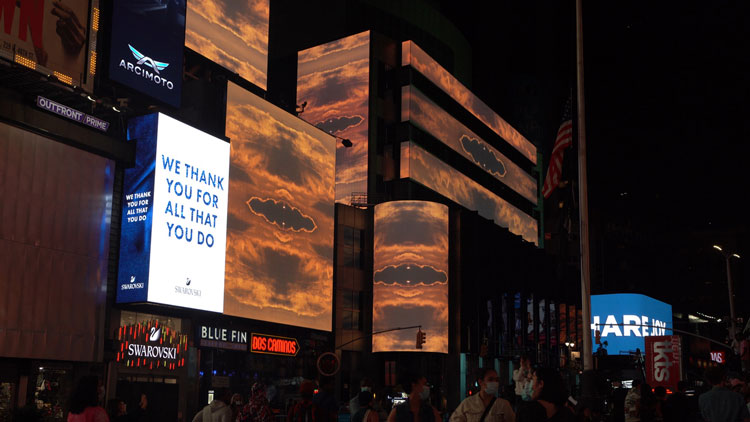
Times Square Midnight Moment: Kambui Olujimi, In Your Absence the Skies Are All the Same, 2020. Photo: Tatyana Tenenbaum, Courtesy Times Square Arts.
Times Square’s Midnight Moment, the nightly, approximately three minutes of digital projection before the witching hour, was on pause, but now is up and running again. For the month of August, it was showing When Horses Were Coconuts by the collective 13BC on its multiple electronic billboards. The haunting underwater footage referred to the atomic bomb and its testing, the water and silence in opposition to the fabricated roar of the exploding mushroom cloud, the stream of luminous waters evoking either the first days of the Earth’s creation or its last. For September, the gaze turns upwards: Kambui Olujimi’s In Your Absence the Skies Are All the Same, shown in collaboration with Project for Empty Space, is a collapsing and expanding reverie about skies from around the world, without borders, it seems, at least for now.
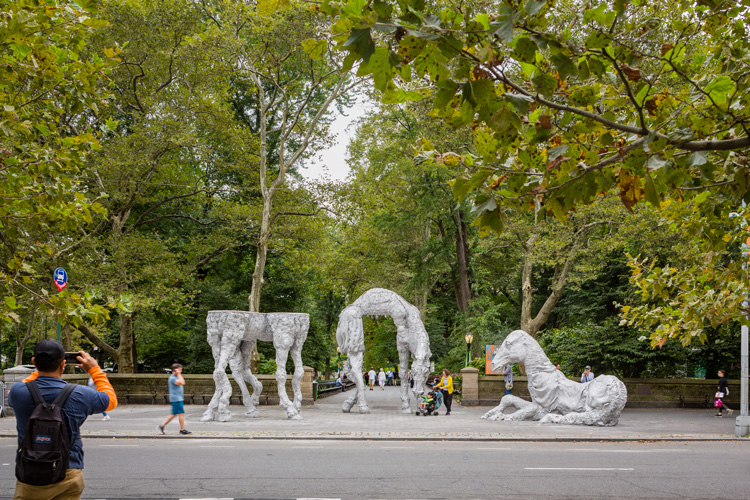
Jean-Marie Appriou, The Horses, 2019. Cast aluminum, courtesy of the artist and CLEARING, New York/Brussels; Galerie Eva Presenhuber, Zürich/New York. Presented by Public Art Fund, Doris C. Freedman Plaza, Central Park, Sep 11, 2019 - Aug 30, 2020. Photo: Nicholas Knight, Courtesy of Public Art Fund, NY.
Also relevant, perhaps, to the heated current discussions swirling around monuments and public art, was the popular installation of surreal, cast aluminium horses curated by Daniel S Palmer and organised by Public Art Fund at the Doris C Freedman Plaza. It had been in residence at the entrance to Central Park and 59th street since last September and was de-installed at the end of August. Created by the French sculptor Jean-Marie Appriou, the horses were in response to the beloved horse-drawn carriages nearby (animal rights activists have sporadically lobbied to ban them) and to the brightly gilded statue of Union general William Tecumseh Sherman, a stone’s throw away. A critique of monuments and a resolution, they were, for starters, all positioned in direct contact with the ground, sans pedestal.
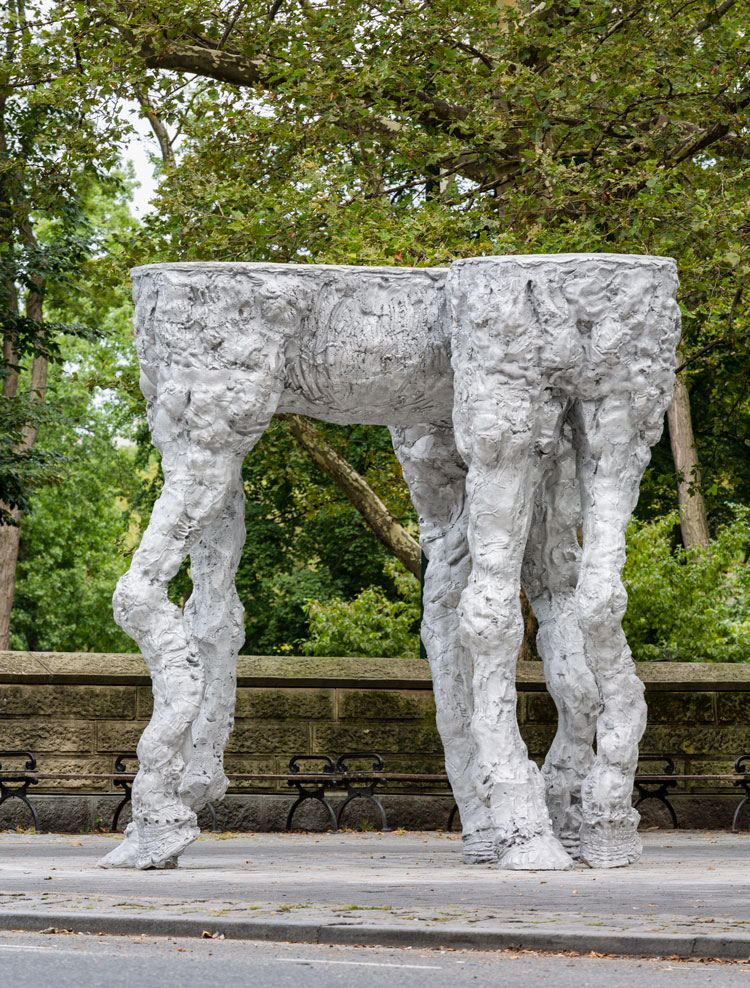
Jean-Marie Appriou, The Horses, 2019. Cast aluminum, courtesy of the artist and CLEARING, New York/Brussels; Galerie Eva Presenhuber, Zürich/New York. Presented by Public Art Fund, Doris C. Freedman Plaza, Central Park, Sep 11, 2019 - Aug 30, 2020. Photo: Nicholas Knight, Courtesy of Public Art Fund, NY.
The beautifully detailed trio, many times enlarged, were also physically deviant, combining fantastical and human traits with the usual equine ones. One was curiously missing the upper half of its body, another was emaciated and improbably arched to form an ungainly portal, and the third, reclining on its haunches, summoned up Don Quixote’s sorry but sympathetic steed, Rocinante.
-Ryan-Muir_P.jpg)
Jean Shin, Floating MAIzE, 2020. Winter Garden, Brookfield Place. Photo: Ryan Muir.
The Brooklyn-based artist Jean Shin is known for innovative, extravagant installations of astonishing beauty made from unlikely objects that focus on environmental issues, recycled materials being her primary medium. Floating MAiZe, which debuted in Lower Manhattan in July is no exception. Suspended under the skylight of the Winter Garden’s vast atrium and surrounded by enormous clear glass walls, the thousands upon thousands of empty Mountain Dew plastic bottles that it required were reclaimed from a previous work by the artist. This shimmering new iteration suggests a lushly leafed canopy, an artificial counterpart to the real (if unnaturally sited) palm trees in this grand evocation of an urban greenhouse. It asks us to think about and combat the consequences of excessive production and consumption, referring here to the plastic and sugar overload that is as lethal as Covid-19, if not more so. With Last Straw, Shin’s other project on view, the exhibition, curated by Kendal Henry, artist and director of the Percent for Art Program, NYC Department of Cultural Affairs, will be up until 18 September as part of the Lower Manhattan Cultural Council’s 2020 River to River festival in partnership with Arts Brookfield.
While galleries and museums across the city plan to reopen over the next few weeks, restrictions will apply, such as 25% capacity, timed tickets or by appointment only, compulsory facemasks and social distancing. For those who are not ready yet to resume indoor viewing, the following are outdoor exhibitions that are now open, jumpstarting the season.
The Metropolitan Museum of Art unlocked its doors on 29 August with exhibitions by Jacob Lawrence and Héctor Zamora, as well as a history of the institution (2020 is its 150th anniversary) and its much-heralded costume exhibit, on hold since May. To welcome back visitors, it has also commissioned DREAM TOGETHER (2020) by Yoko Ono. Each of the two white super-sized banners is imprinted with one of the words, her response to the pandemic, and has just been installed on its facade, a space normally reserved for announcing current exhibitions.
Yoko Ono, DREAM TOGETHER, 2020, installed at The Metropolitan Museum of Art.
Another first is the four regal – if also enigmatic – Wangechi Mutu bronze sculptures of women, The New Ones, will free Us (2019), commissioned last year for the vacant niches of its magnificent beaux-arts facade. Mutu’s liberated “caryatids” are part of MMA’s initial programme to bring art out of the galleries into public space and are up until November, when works by Carol Bove will replace them.
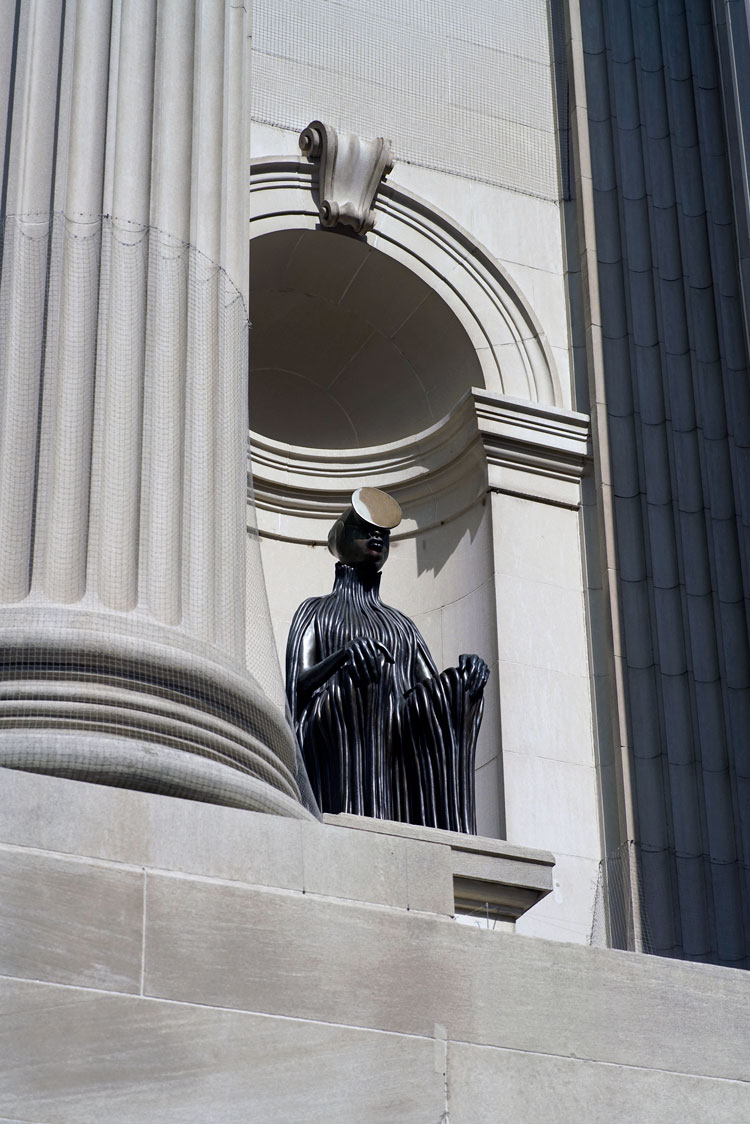
Wangechi Mutu, The NewOnes, will free Us, 2019, installation view, The Metropolitan Museum of Art. Photo: Miguel Benavides.
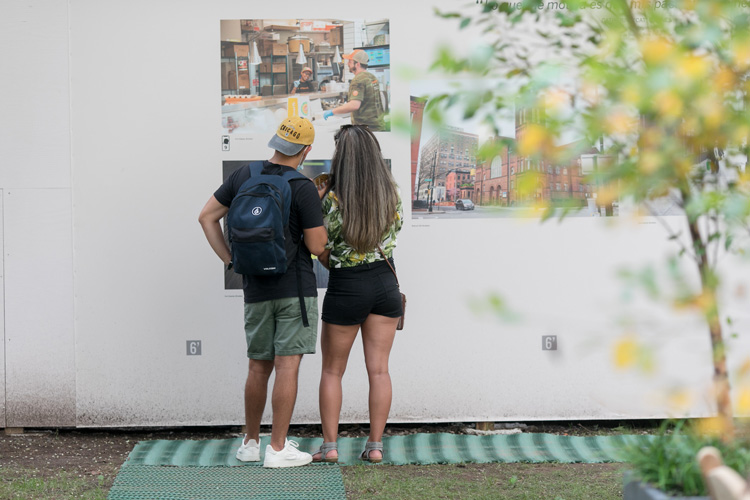
Hope Wanted: New York City under Quarantine. New York Historical Society. Photo: Phillip van Nostrand.
Uptown, near Central Park and 77th Street, the New York Historical Society is hosting Hope Wanted: New York City Under Quarantine (until 29 November), turning its rear courtyard into an outdoor exhibition space. The presentation consists of insightful, empathetic text by poet and journalist Kevin Powell and photographs taken by Kay Hickman centred on ordinary New Yorkers in their neighbourhoods during the pandemic. There are also sensitive interviews with more than a dozen of the people they talked to over their two-day sprint across the five boroughs, which can be accessed on viewers’ smartphones.
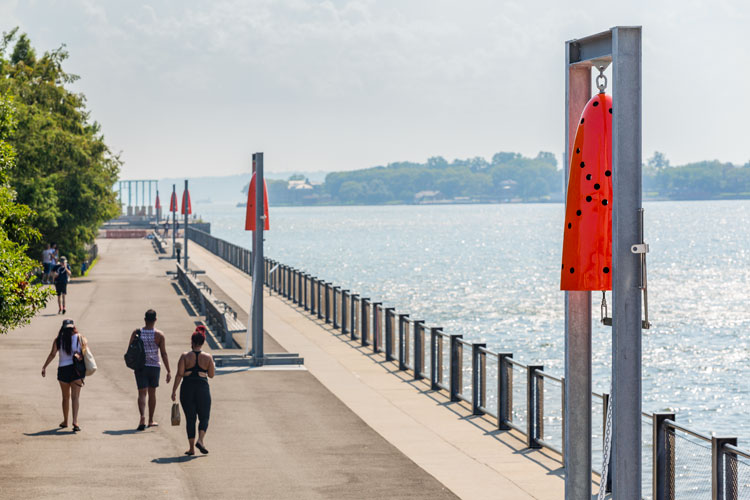
Davina Semo, Reverberation, 2020. Patinated cast bronze bell, UV protected 2-stage catalyzed urethane automotive finish, galvanized steel chain and hardware, clapper.
Presented by Public Art Fund at Brooklyn Bridge Park Pier 1, 20 August 2020 – 18 April 2021. Courtesy the artist and Jessica Silverman, San Francisco. Photo: Nicholas Knight, Courtesy of Public Art Fund, NY.
Across the East River, at the Brooklyn Bridge Park, another Public Art Fund project curated by Palmer is now open until 18 April 2021. By San Francisco-based artist Davina Semo, it is titled Reverberation, a handsome installation that consists of five cast bronze bells (Dream, Listener, Mother, Reflector, Singer). Their austerity is counteracted by the richness of the luminescent red-orange that coats them, as well as the sounds they produce. Each bell, drilled with a different pattern of holes, produces a distinctive tone. Suspended in individual 14-foot (4.25 metre) high armatures, the bells summon thoughts about good news and bad, history and maritime history, systems of communication, the civic nature of public art and its vital role in the life of communities. Meant to be rung by viewers, they are a call to congregate, to participate and to act.
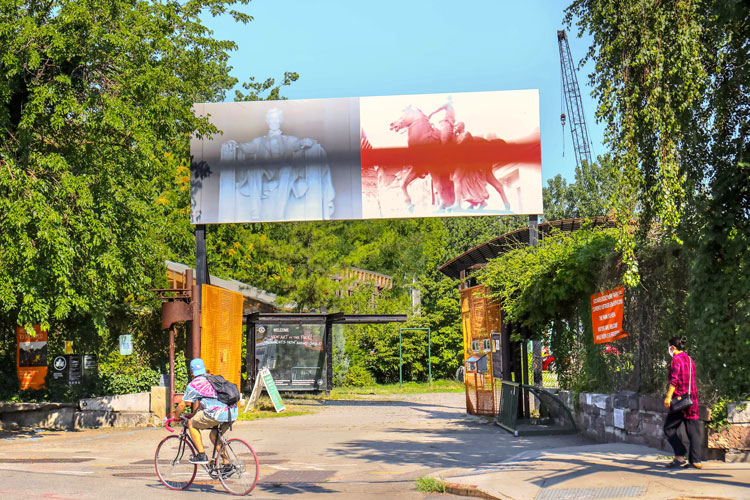
Nona Faustine, In Praise of Famous Men No More, 2020. Courtesy the Artist and Socrates Sculpture Park. Photo: Chris Zirbes.
Socrates Sculpture Park in Long Island City, founded in 1986 by Mark di Suvero and others on an illegal dumpsite, is presenting Monuments Now, a multi-part project with staggered openings through October, up until March 2021. Nona Faustine’s billboard at the entrance to the park, with its cancelled images of the Lincoln Memorial in Washington DC and the beleaguered Theodore Roosevelt sculptural ensemble in front of New York’s Natural History Museum resoundingly proclaims the theme. Curated by Jess Wilcox, it is another timely show that addresses the urgent need to redefine the role of public art and to reconsider the iconography of public monuments, making them more socially and politically inclusive in representation.

Jeffrey Gibson, Because Once You Enter My House It Becomes Our House, 2020. Photo: Courtesy of the artist and Socrates Sculpture Park.
The works of three New York-based artists were selected for Part I. Jeffrey Gibson’s Because Once You Enter My house, It Becomes Our House debuted the project in late July, with a dedication by the Indigenous Kinship Collective and a performance by noted violinist Laura Ortman. Disarmingly, disingenuously pastel-hued, the tri-level ziggurat is backgrounded by the glass and steel Manhattan skyline across the East River, striking a pointed contrast. It rises confidently from the park’s expansive field, its structure a reference to the earthen mounds of ancient Cahokia, a pre-Columbian metropolis of the Mississippian people (the artist is Mississippi Choctaw-Cherokee), its psychedelic op-art patterns also sourced in Mississippian culture. Words and activist phrases embedded in the design, such as “land,” act as a tripwire, a reminder of centuries of illegal trespass and confiscation, and the continuing betrayal of America’s original inhabitants.

Paul Ramírez Jonas, Eternal Flame, 2020. Photo: Lilly Wei.
Paul Ramírez Jonas’ Eternal Flame opened around three weeks later, in mid-August, his obelisk rising from a base that holds within it not the conventional sacred fire, but four charcoal grills, flanked by cheerfully painted picnic tables. His eternal flame is not, it turns out, a reverent, elegiac tribute to valour or death. Instead, it embraces cooking, and sharing what has been cooked, the mundane task that binds people and communities together around the world, arguably more tightly than any other bond. This domesticated monument, or perhaps this monument to domesticity, its utilitarian flame constantly lit – as the press release states, someone somewhere is always cooking – celebrates life rather than death. It is a joyful, playful ode to the quotidian, surely a more satisfying model. Who doesn’t like or need to eat? While not available to the public to grill on due to the pandemic, a series of videos featuring chefs discussing the symbolism of the eternal flame across cultures, as well as the stories behind the dishes they are preparing, will be released during the run of the installation.
The third artist is Xaviera Simmons, whose installation opened officially on 29 August. She has created three imposing upright slabs that are clearly modelled on a classic formulation for public monuments (such as the enormous stone cube engraved with Roosevelt’s eloquent Four Freedoms speech in the Kahn park downriver, its lofty aspirations in ironic dissonance with Simmons’s less utopian text).

Xaviera Simmons, The structure the labor the foundation the escape the pause, 2020. Photo: Lilly Wei.
Titled The structure the labor the foundation the escape the pause (2020), the text in her monuments is hand-inscribed, extracted from historical documents that paper a trail of broken promises to black Americans, including an 1865 document (commonly known as 40 Acres and a Mule) that granted land and federal protection to former slaves. Simmons joins together the language of past official policies with current demands for restitution, the systemic duplicity amplified in her placement and parsing of the words, emphasising how long overdue reparations have been and how long justice has been delayed, a state of inequity exponentially highlighted in our time of pandemic.